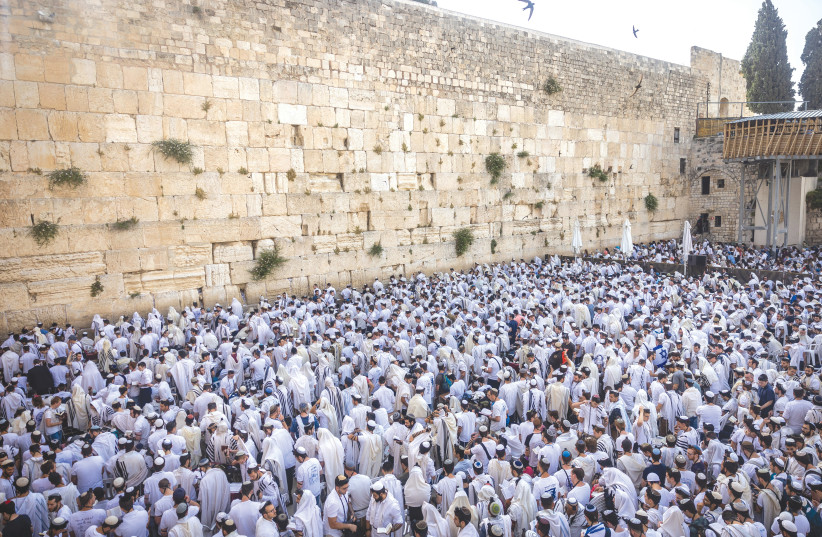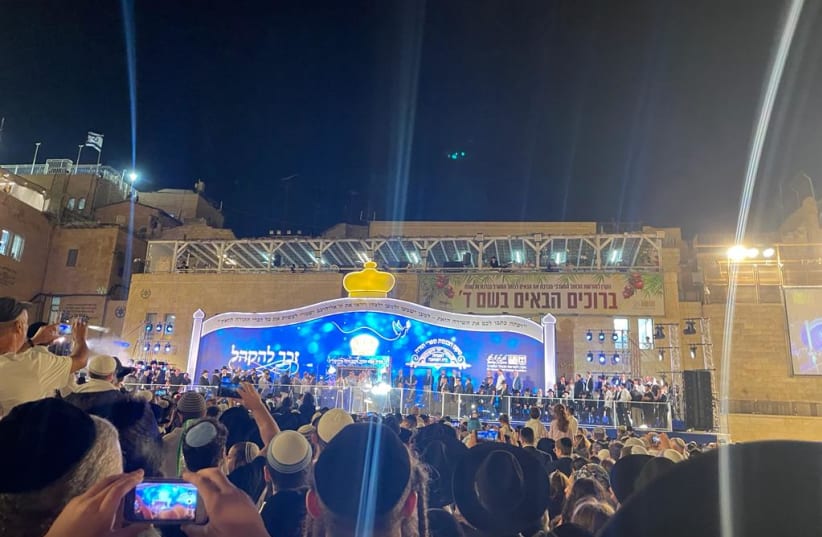In modern Israel, the ancient Hakhel ceremony is reenacted in Jerusalem every seven years on the second intermediate day of the Sukkot holiday. I wanted to go. I consider myself a youthful septuagenarian but can’t count on being sufficiently nimble to descend and ascend the even older Old City’s stone steps by the next Hakhel.Like many decisions, attending had its share of deliberating the pros and cons.
The pro is straightforward: Taking part in a historic ceremony, a Torah mitzvah of yore, brought back in modern Israel, is a meaningful and thrilling experience.
There are Hakhel ceremonies in the Diaspora, too, albeit with different content and formats.
What is Hakhel?
The Hebrew word “hakhel” is the command “assemble!” In Deuteronomy (31:10-12), Moses instructs our Israelite foreparents: “Assemble the people – men, women, children and the strangers in your communities – that they may hear and so learn to revere your God and to observe every word of this teaching.”


The assembly took place at the end of the sabbatical year, with no less than the king reading from the Torah. It disappeared after 70 CE, following the destruction of the Second Temple and our dispersion.
The spoils of the ravaged Temple are portrayed on the Arch of Titus in Rome. The image of the menorah on the Arch is the specific menorah chosen for the symbol of the State of Israel – a statement that we’re back in our homeland. Many times have I stood on the overlook at Hadassah-University Medical Center, on Jerusalem’s Mount Scopus, and recalled for visitors the inscription on coins issued by Emperor Vespasian: “Judea Capta” (Captured Judea). Renewing an ancient tradition in my vibrant modern hometown feels powerfully right to me.
The revitalization of Hakhel is actually credited to Lithuania-born Rabbi Eliyahu David Rabinowitz-Teomim, known as the “Aderet” (and the father-in-law of Rabbi Abraham Isaac Kook), before his own move to Jerusalem. He penned a 27-page book printed in 1889 in Warsaw suggesting that even though the majority of Jews didn’t live in Israel, Hakhel should be observed. The Aderet died before the ceremony took hold in the 1940s.
The cons of attending such a ceremony might include demophobia, agoraphobia – in other words, a dislike of being part of a potentially huge, pressing crowd. These fears are heightened by the 2021 images of the deadly crush from Lag Ba’omer 2021 in Meron, of a celebration turning into a tragedy, with 45 persons killed and some 150 others injured. The recent wave of terrorist attacks did raise concerns for my husband and me, mainly because a good sampling of our children and grandchildren would be joining us. The event was also scheduled for after dark.
WE DECIDED to go, to take reasonable precautions, and to make decisions about leaving on site. We weren’t sorry.
To make the experience more meaningful and to avoid the crowded alleyways leading to the Western Wall, we booked a child-friendly walk on the Old City walls. This was very sparsely attended and reminded me how we sometimes neglect the most accessible historic sites right in our hometown, thinking that the kids visit these all the time in school or in youth movements. The wall walk was new and fascinating to all of them.
And then, to our surprise and delight, we all got seats in the fast-service Burgers Bar above the Western Wall Plaza. That meant the event might not be as crowded as predicted.
Still, with some trepidation we joined the orderly human wave heading down the steps to the plaza. The feared crowd at the Kotel wasn’t fearful at all. Somehow there was room for everyone – even though the crowd was estimated at 50,000. I was reminded of the miracles of Temple time: Rav Yehuda taught in the name of Rav that when the Jewish people came to Jerusalem on Passover, Shavuot and Sukkot, there was always enough space for everyone to bow at the appropriate time. And Sukkot was reputedly the most crowded of the three pilgrimage holidays back then.
Despite the biblical command to include women in Hakhel, the Hakhel stage and the musical performance had no hint of a womanly presence. No woman spoke, let alone sang. Nonetheless, most of the gathered multitude ignored the repeated announcements to separate into men’s and women’s sections. There were segregated sections adjacent to the Wall, but like us, most people stood as families. I am in wonder at the intrepid women who matter-of-factly traversed the stones and steps with baby carriages and strollers, carrying one or multiple offspring, unwilling to miss out on this spectacular event.
The majority of participants were religiously attired Jews of all shades and head coverings. But not all. There were teens in jeans and bareheaded men and women aplenty.
The echo of the Sheheheyanu prayer thanking God for allowing us to make it to this occasion with 50,000 voices in unison saying amen was, as our grandchildren say, “madhim” – Hebrew for “awesome.”
We don’t have a king, but we have a president from a distinguished dynasty. President Isaac Herzog’s grandfather Ashkenazi chief Rabbi Yitzhak Halevi Herzog and his father, president Chaim Herzog, both took part in the previously revived Hakhel ceremonies. Our own President Herzog read Psalm 122: “Our feet were standing within your gates, O Jerusalem; built-up Jerusalem is like a city that was joined together within itself.... Request the welfare of Jerusalem; may those who love you enjoy tranquility,” and the oft sung “May there be peace in your walls, tranquility in your palaces. For the sake of my brethren and my companions I shall now speak of peace in you....”
Herzog then chanted from Isaiah (52:7-12), “Raise a shout together, O ruins of Jerusalem! For the Lord will comfort His people, redeem Jerusalem.”
It’s pleasing to have a president who knows the traditional cantillation. As one of our granddaughters reminded me, “His grandfather was a rabbi.”
Three Torah scrolls were dedicated by male rabbis and dignitaries, and the event segued to a Simhat Beit Hashoeva, a festive continuation of the Water Libation celebration (sans water), with even some dancing.
So many families were still coming to join the celebration, even after the opening ceremonies had been completed, that the heavily guarded Old City streets were made one-way in or one-way out for walkers, too.
The next Zecher L’hakhel is scheduled for September 26, 2029. Put it on your calendar. The Messiah may be reading. I wonder what accent her Hebrew will have!
The writer is the Israel director of public relations at Hadassah, the Women’s Zionist Organization of America. Her latest book is A Daughter of Many Mothers.
